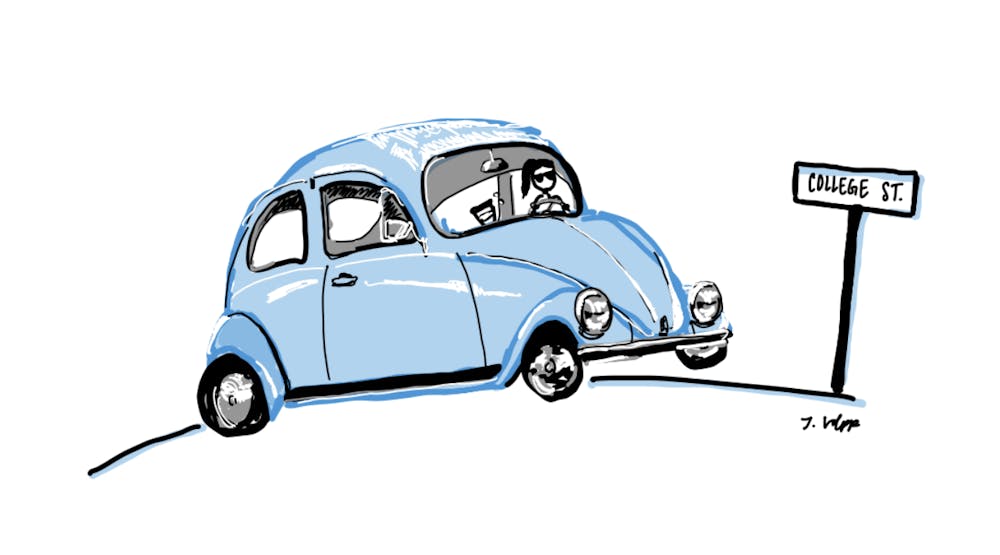My car broke down three weeks ago in Erie, Pa. I loved my 2013 Jetta Hybrid, but it had a lot of problems. The transmission leaked, it was hard to put in gas and the “check engine” light was always on. Still, I was proud of that car because I worked my butt off to pay for it. But when my Jetta and I arrived at Middlebury for the first time almost four years ago, I was flabbergasted by the cars that I was parked next to. I rattled past spiffy Audis and flashy BMWs, wondering how college students managed to pay for such pricey vehicles. Most of my friends back home bought their own cars. It seemed preposterous that parents would give their child something so luxurious — and so expensive.
The wealth inequality present in the college’s parking lots is representative of a nationwide trend. In 2022, the wealthiest families held 71 times the wealth of middle-class families, whereas in 1963 the wealthiest families had ‘only’ 36 times the wealth of middle-class families. Although Middlebury’s admissions policy is need-blind for domestic students, our institution consistently ranks in the top 10 U.S. colleges with the wealthiest students. Only 51% of students receive any sort of financial aid, in spite of a sticker price that is rapidly closing in on $90,000. Middlebury has a $1.5 billion endowment and a huge amount of influence; as wealth inequality continues to skyrocket in the U.S., the college must use its financial resources to help uplift more students from lower-income backgrounds.
Middlebury’s wealth allows it to support a need-blind admissions process, meaning the college does not take an applicant’s ability to pay Middlebury tuition into account in their admissions decision. This motivates students of all financial backgrounds to apply to Middlebury, knowing that they will have a fair shot at accessing one of the nation’s elite liberal arts colleges. However, the need-blind process has some drawbacks. Although need-blind admissions is a superior approach to need-aware admissions, it fails to take into account the significant advantages that wealthy students often have in meeting merit or academic-based admission standards.
As a low-income student, I did not have access to tutoring, test preparation courses, elite extracurricular activities, and the like. Thus, wealthier students who did have access to these assets are disproportionately represented in our student body due to their ability to build stronger application profiles. Furthermore, Middlebury’s long-standing preference toward legacy students reinforces the advantages accumulated by prior generations of wealthy Middlebury families, continuing to perpetuate socioeconomic disparities in admissions. While I am not arguing for the discontinuation of a need-blind admissions model, I am contending that Middlebury needs to more comprehensively address the inequities embedded within its current system.
There are a number of steps that Middlebury could take to improve the representation of low-income students within their ranks. Right now Middlebury’s “For Every Future” campaign is attempting to woo first-time financial aid contributors by matching donations up to $10 million. This is a step in the right direction but fails to address the systemic issue: Students from low-income backgrounds have a lower chance of getting admitted to Middlebury in the first place. In a recent editorial, The Campus argued that, in the wake of the ban on affirmative action, Middlebury must redouble its outreach efforts in low-income communities and end the preferential treatment of legacy applicants. I would add that outreach should not consist solely of “showing up” in low-income areas, but should show students how to build an attractive application profile. These steps would allow Middlebury to build relationships with students who may not traditionally consider elite institutions as accessible options.
On a recent Freakonomics Radio Podcast, economist Peter Blair argued that if elite institutions do not expand their study body in proportion to the increase in their influence and financial resources, they begin to function as “luxury goods.” Like an Hermès bag or a Canada Goose jacket, the Middlebury bumper sticker on the back of your car serves as a status symbol, reminding others of the prestige associated with attending one of the nation’s top liberal arts colleges. Essentially, your Middlebury education signifies not only an immense academic achievement but also a connection to a certain socioeconomic class. Research suggests that the higher the tuition fee a school charges, the higher the future earnings of its graduates; this correlation is even more pronounced for students from disadvantaged backgrounds.
As elite universities tighten their belts against an onslaught of ever-more-qualified applicants, Blair argues that schools with the means to do so should increase their enrollment. By de-emphasizing prestige and sharing their resources, I propose that a consortium of elite universities could work together to mitigate wealth inequality, allowing a larger and more diverse pool of students access to social mobility and a rigorous education. Although this step is radical, if Middlebury and its students are indeed committed to social responsibility and compassion, they might consider putting aside their “luxury brand” education in favor of opening doors and closing gaps.
Ironically, after the untimely demise of my Jetta, I am now driving my mom’s Prius. It gets excellent gas mileage and requires no extra encouragement when going up a steep hill. I have yet to figure out how I’m going to pay for it. I’m still parking next to flocks of Lexuses and Cadillacs, but I am optimistic that, one day, Middlebury’s parking lot — and student body — will be more heterogeneous.
Haydn Suske-Funk (he/him) is an Opinions Editor.
Haydn is a Conservation Biology major and French minor from Northern Wisconsin. He spent his summer working for the Forest Service and hiking in the beautiful Green Mountains. On campus, he works as a research assistant for the college lands conservationist, hosts a longstanding show on 91.1 WRMC, and hangs out at the climbing wall. In his free time, Haydn enjoys reading, playing guitar, and embarking on a variety of entertaining but poorly-planned adventures into the wilderness.




